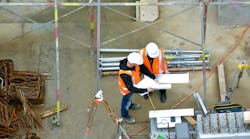Construction employment increased in 26 states between July 2010 and July 2011 and during the past month, according to an analysis by the Associated General Contractors of America (AGC) of state employment data released by the U.S. Department of Labor. The relatively even split between states adding and losing construction jobs was to be expected given the fact that overall employment in construction was relatively stagnant in July, association officials noted. "When it comes to construction employment, for every state adding jobs there is another one shedding just as many or more," said Stephen E. Sandherr, the association’s CEO. "The fact that this industry is breaking even when it comes to construction employment is little comfort for many unemployed construction workers."
The largest percentage increase in construction employment during the past year took place in North Dakota (19.0%, 4,000 jobs). Other states experiencing large percentage increases included Illinois (8.2%, 15,400 jobs); Michigan (8.0%, 9,600 jobs) and Oklahoma (6.0%, 4,000 jobs). Texas added the most jobs during the past year (23,800 jobs, 4.2%); followed by Illinois; California (13,100 jobs, 2.4%) and Michigan. Among the 23 states that lost construction jobs during the past 12 months, Georgia (-9.9%, -14,800 jobs) had the highest percentage decline. Other states with large percentage declines included New Mexico (-8.9%, -3,900 jobs); Colorado (-8.6%, -9,800 jobs) and Idaho (-7.9%, -2,400 jobs). Florida (-23,000 jobs, -6.5%) lost the most jobs followed by Georgia; Colorado and North Carolina (-6,300 jobs, -3.6%).
Construction employment was unchanged for the year in Vermont. Montana had the largest percentage increase (7.0%, 1,500 jobs) in construction jobs during the past month; followed by Utah (4.3%, 2,800 jobs); Arkansas (3.8%, 1,800 jobs) and Iowa (2.6%, 1,600 jobs). California (3,200 jobs, 0.6%) added the largest number of jobs; followed by Utah; Missouri (2,500 jobs, 2.4%) and Tennessee (2,400 jobs, 2.2%).
The largest percentage decline among the 24 states that lost construction jobs between June and July occurred in Alaska (-4.3%, -700 jobs); followed by Idaho (-3.8%, -1,100 jobs); Georgia (-2.8%, -3,900 jobs) and Minnesota (-2.3%, -2,000 jobs). The largest number of construction job losses over the month was in Texas (-6,000 jobs, -1.0%); followed by Florida (-5,800 jobs, -1.7%); Illinois (-4,300 jobs, -2.1%) and Georgia.
Association officials noted that contractors around the country were reporting that they have been forced to reduce staff because of cutbacks in many federally funded construction projects. They also noted that unless Washington officials are willing to allow broken bridges and other neglected public structures to remain out of service, taxpayers would end up paying more to fix infrastructure than they would to maintain it now.

